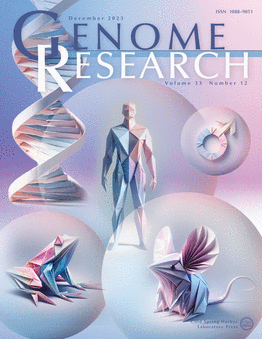Exon nomenclature and classification of transcripts (ENACT) provides a systematic framework to annotate exon attributes
IF 5.5
2区 生物学
Q1 BIOCHEMISTRY & MOLECULAR BIOLOGY
引用次数: 0
Abstract
Isoform diversity is known to enhance a gene's functional repertoire by producing protein variants with distinct functional implications. Despite numerous studies on transcriptome diversifying processes (alternative splicing/transcription), understanding their extent and correlated impact on proteome diversity remains limited owing to dearth of subsequent proteogenomic consequences. To coalesce the genomic information embedded in exons with isoform sequences, we present an innovative framework, “Exon Nomenclature and Classification of Transcripts” (ENACT). This centralizes exonic loci such that protein sequence information is integrated (onto the available/annotated or new transcripts) while enabling tracking and assessing splice-site variability through unique yielded descriptors. The resulting annotation from the ENACT framework enables exon features to be tractable, facilitating a systematic analysis of isoform diversity. Our findings and case studies unveil systemic exon inclusion roles in regulating diversity in coding region. Correspondingly, annotation of protein-coding genes and associated transcripts from C. elegans, D. melanogaster, D. rerio, M. musculus, and H. sapiens are publicly accessible in a dedicated resource.外显子命名和转录本分类(ENACT)为外显子属性的注释提供了一个系统的框架
已知同种异构体多样性通过产生具有不同功能含义的蛋白质变体来增强基因的功能库。尽管对转录组多样化过程(选择性剪接/转录)进行了大量研究,但由于缺乏后续的蛋白质基因组学结果,对其程度和对蛋白质组多样性的相关影响的了解仍然有限。为了将嵌入外显子的基因组信息与异构体序列结合起来,我们提出了一个创新的框架,“外显子命名法和转录本分类”(ENACT)。这集中了外显子位点,使蛋白质序列信息被整合(到可用的/注释的或新的转录本上),同时通过产生的独特描述子跟踪和评估剪接位点的可变性。从ENACT框架得到的注释使外显子特征易于处理,从而促进了对异构体多样性的系统分析。我们的发现和案例研究揭示了系统外显子包含在调节编码区多样性中的作用。相应的,秀丽隐杆线虫、黑肠线虫、黑肠线虫、肌肉线虫和智人的蛋白质编码基因注释和相关转录本也可以在一个专门的资源中公开获取。
本文章由计算机程序翻译,如有差异,请以英文原文为准。
求助全文
约1分钟内获得全文
求助全文
来源期刊

Genome research
生物-生化与分子生物学
CiteScore
12.40
自引率
1.40%
发文量
140
审稿时长
6 months
期刊介绍:
Launched in 1995, Genome Research is an international, continuously published, peer-reviewed journal that focuses on research that provides novel insights into the genome biology of all organisms, including advances in genomic medicine.
Among the topics considered by the journal are genome structure and function, comparative genomics, molecular evolution, genome-scale quantitative and population genetics, proteomics, epigenomics, and systems biology. The journal also features exciting gene discoveries and reports of cutting-edge computational biology and high-throughput methodologies.
New data in these areas are published as research papers, or methods and resource reports that provide novel information on technologies or tools that will be of interest to a broad readership. Complete data sets are presented electronically on the journal''s web site where appropriate. The journal also provides Reviews, Perspectives, and Insight/Outlook articles, which present commentary on the latest advances published both here and elsewhere, placing such progress in its broader biological context.
 求助内容:
求助内容: 应助结果提醒方式:
应助结果提醒方式:


